|
Sunflower Family (Asteraceae)
| WAYNE'S WORD Volume 9 (Number 3) Fall 2000 |
Sunflower Family (Asteraceae)
The Largest Plant Family On Earth

|
The Transvaal daisy (Gerbera jamesonii), a vivid red daisy native to the Transvaal region of South Africa. Many beautiful color variations of this perennial are cultivated in southern California.
|
|
The largest family of flowering plants is the ubiquitous sunflower family (Asteraceae or Compositae). According to James L. Reveal of the University of Maryland (personal communication, 2000), the family contains nearly 1550 genera and 24,000 species. The sunflower family is rivaled in size only by the orchid family (Orchidaceae) with approximately 20,000 species and the legume family (Fabaceae) with about 18,000 species. In fact, if all the known species of flowering plants on earth were randomly lined up, every fourth one would belong to the sunflower, orchid or legume families. The sunflower family includes a great diversity of species, including annuals, perennials, stem succulents, vines, shrubs and trees. It is well-represented in parks and gardens throughout the world, with bedding plants, ground covers and shrubs. Familiar common names, such as daisies, marigolds, zinnias, gazanias, chrysanthemums, dandelions, thistles, ragweeds, sagebrush, cosmos and dahlias all belong to this family.
Capitulum: Inflorescence Of The Sunflower Family

|
A capitulum or head, the characteristic inflorescence of the sunflower family (Asteraceae). Depending on the tribe, the inflorescence may consist of ray flowers, disk flowers, or both ray and disk flowers. The ovary of each flower is situated below the attachment of the corolla and stamens, a condition referred to as epigynous or inferior. This is the largest family of flowering plants with approximately 24,000 species. The variation in disk and ray flowers is astonishing.
|

|
Dahlia imperialis, a perennial native to southern Mexico and Central America.
|

|
The Panamint daisy (Enceliopsis covillei), an endemic wildflower in the isolated Panamint Range of California. This species is also the official logo for the California Native Plant Society (CNPS).
|
Throughout San Diego County and the southwestern United States (where Wayne's Word is based), this family is usually represented by the largest number of wild species in coastal mountain and desert regions. In many areas of the world, members of this family comprise 10 to 20 percent of the total flora. The family also includes numerous endemic species that only grow on one isolated mountain range or island, such as the remarkable silver sword (Argyroxiphium sandwicense var. macrocephalum) endemic to Haleakala Crater on the Hawaiian Island of Maui and the beautiful Panamint daisy (Enceliopsis covillei) endemic to California's Panamint Range. In addition, the family includes many economically important herbs and vegetables, and has some of the world's most widespread and successful weedy species with very effective hitchhiker seeds and seeds dispersed by air currents.

|
Some striking members of the sunflower family evolved on the Hawaiian Islands from an ancestral California tarweed (Hemizonia) that colonized these isolated Pacific islands millions of years ago. This group of plants, called the Silver Sword Alliance, includes three genera and about 30 endemic species, an excellent example of adaptive radiation.
|

|
Lecocarpus pinnatifidus, an endemic shrub found only on Floreana (Santa Maria) Island in the Galapagos Archipelago. It often grows as a pioneer species on lava and cinders at low elevations. Photo taken at dusk, with the infamous M/N Bucanero in the distance.
|
Additional Photos Of Representative Species
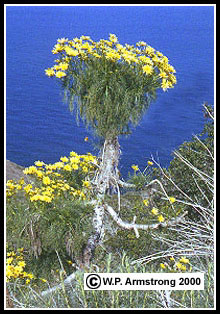
|
Giant sea dahlia (Coreopsis gigantea), a remarkable shrubby daisy found on coastal bluffs of central California and the California Channel Islands.
|
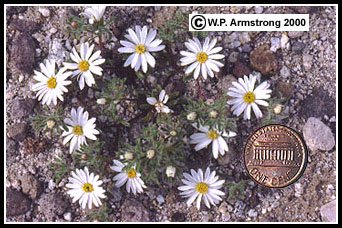
|
Desert star (Monoptilon bellioides), a small, prostrate daisy found in gravelly areas of the Colorado Desert in southern California. The tiny flowers are smaller than a U.S. penny.
|

|
Minute flower head of a fleabane (Conyza floribunda) compared with a U.S. penny. This late-summer to fall annual is naturalized in San Diego County from tropical America. It is sometimes called "asthmaweed."
|
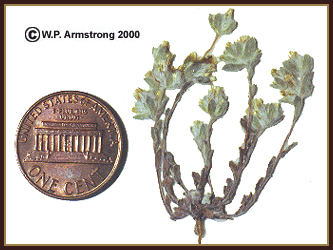
|
Dwarf fluffweed (Filago depressa), a diminutive member of the sunflower family (Asteraceae) found in sandy areas of Anza-Borrego Desert State Park in southern California. This whitish-gray herb is covered with white-wooly hairs, characteristic of the everlasting tribe (Inuleae).
|

|
The tiny, one-seeded achenes of dwarf fluffweed (Filago depressa) are small enough to pass through the eye of an ordinary sewing needle. These minute structures are technically one-seeded fruits, and they certainly represent some of the smallest fruits on earth. Of course, the undisputed record for the world's smallest fruit goes to the genus Wolffia, a member of the duckweed family (Lemnaceae).
|
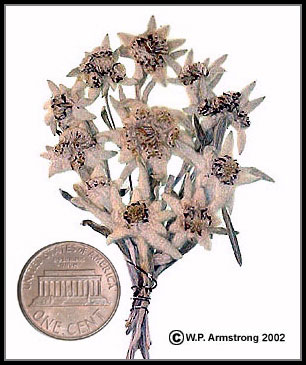
|
Edelweiss (Leontopodium alpinum), a rhizomatous perennial native to the alpine tundra region of the Swiss Alps. It is covered with white-wooly hairs, typical of the everlasting tribe (Inuleae) of the sunflower family (Asteraceae). This interesting species has become synonymous with the high country of European mountains, including the Pyrenes, Alps and Carpathian mountains. The U.S. penny (one cent) is shown as a size relationship.
|

|
Orcutt's woody aster (Xylorhiza orcuttii): A rare, shrubby daisy native to arid canyons and sandy areas with gypsum soils in the Anza-Borrego Desert of San Diego County.
|

|
The daisy tree (Montanoa arborescens): An unusual, treelike sunflower with a woody trunk that is native to Mexico.
|
Stephanomeria: Interesting Annuals In Southern California
|
San Diego Wreath Plant (Stephanomeria diegensis)
This is a tall annual with a large, thick taproot. It is native to chaparral areas of San Diego County. During late spring and summer, it appears along roadsides and dry, disturbed slopes. In the hottest and driest months it grows very rapidly into a tall, upright axis with numerous ascending branches, each with solitary or clustered heads at the nodes. The plant in left photograph (black arrow) was photographed in December, 2003 along a dirt road in the Merriam Mountains of northern San Diego County. It was about 8 feet (2.4 m) in height and still had many heads with flowers in bloom.
|

|
San Diego Wreath Plant (Stephanomeria diegensis)
The heads of this species are ligulate (strap-shaped) and without tubular disk flowers. They are sessile or on short peduncles. The phyllaries are in two distinct sets, the inner (longer) and outer (shorter). The outer, shorter phyllaries are erect and appressed, not reflexed. In addition, the phyllaries are not glandular as in other species. Each head contains up to 12 achenes representing 12 separate flowers. The achenes are longitudinally ribbed with rows of minute tubercles, and with a narrow groove (crack) between the tuberculate ribs. In the Jepson Manual of California Plants, if one interprets the groove as only a valley between the tuberculate ribs, this species would key out to S. virgata ssp. pleurocarpa. The two species are very similar overall, and many specimens of S. diegensis have been misclassified as S. virgata.
|
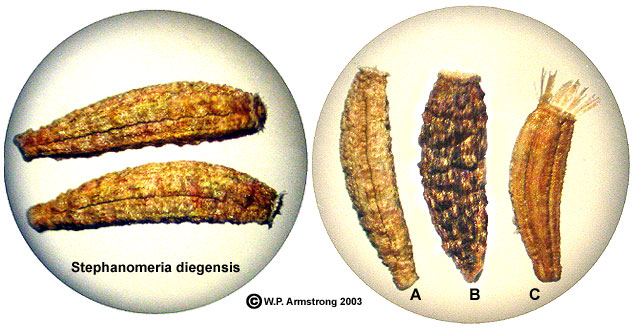
|
Achenes From 3 Species of Stephanomeria in San Diego County
Left: Stephanomeria diegensis. The minute one-seeded fruits (achenes) are about 3 mm in length. Each achene has a narrow longitudinal groove (crack) down the center of one or more sides. Right: Achenes from three species of Stephanomeria in southern California. A. S. diegensis. B. S. virgata ssp. pleurocarpa. The achenes are tuberculate-ribbed without a groove between the ribs. C. S. exigua ssp. deanei. The 5-sided (angular) achenes have a distinct longitudinal groove on each side. They also have a persistent pappus base at the apical end.
|

|
San Diego Wreath Plant (Stephanomeria diegensis)
Left: A seed head composed of 12 achenes, each with a pappus of hairs resembling a parachute. Individual hairs are plumose at their upper ends with numerous branched hairs. Right: Like miniature parachutes the achenes become airborne with the slightest gust of wind. Airborne achenes such as these have enabled species in this remarkable family to cross prominent barriers of land and sea to colonize new habitats. With 12 seeds per head, and many hundreds of heads during its long blooming season, there is a good possibility that some airborne achenes of this annual will land in a suitable spot for the next season's crop.
|
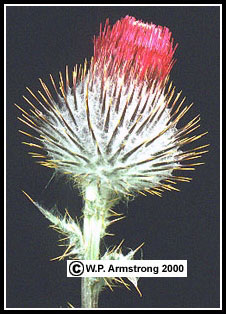
|
Western thistle (Cirsium occidentale), a striking red thistle native to San Diego County. Between the sharp spines are masses of white, arachnoid hairs resembling the cobweb of a spider.
|

|
California thistle (Cirsium californicum), a striking pink-flowered thistle native to coastal and mountain areas of San Diego County. In this photo the thistle serves as a convenient resting place for a Western Tiger Swallowtail butterfly (Papilio rutulus). This large California butterfly has a wing span of up to four inches (10 cm).
|

|
Bird's nest thistle (Cirsium scariosum), a low-growing thistle native to meadows in the mountains San Diego County. This variable species is also listed as C. drummondii and C. tioganum in some references. The immature heads (inflorescences) superficially resemble eggs in a bird nest. Stepping on this thistle barefooted can be a painful experience.
|

|
Star thistle (Centaurea solstitialis), a European annual of the sunflower family (Asteraceae) that has become a troublesome naturalized weed in the Central Valley of California. The involucre is composed of overlapping bracts (phyllaries), each tipped with a slender spine. The dry, stiff spines can readily penetrate skin and can puncture bicycle tires. Another yellow-flowered species with shorter spines (C. melitensis) is naturalized in disturbed areas of southern California. A purple-flowered perennial species without involucral spines is called Russian knapweed (C. repens). The latter species is listed under the genus Acroptilon in the Jepson Flora of California, 1993. Although the genus includes some of the worst weeds in California's pasturelands, it also includes some popular garden ornamentals, such as "dusty miller" (C. cineraria).
|

|
Spotted knapweed (Centaurea biebersteinii) in northern Montana. The flower head is subtended by black-tipped phyllaries, each tipped with a fringe of hairs. In the star thistles, each phyllary is tipped with a slender spine.
|
|
Boneseed (Chrysanthemoides monilifera ssp. monilifera), a South African evergreen shrub that is naturalized in the hills of coastal sage scrub adjacent to Palomar College in San Diego County, California. This shrub has become a serious naturalized weed in Australia, forming massive thickets in all southern Australian states. It has also become an invasive weed in New Zealand.
|
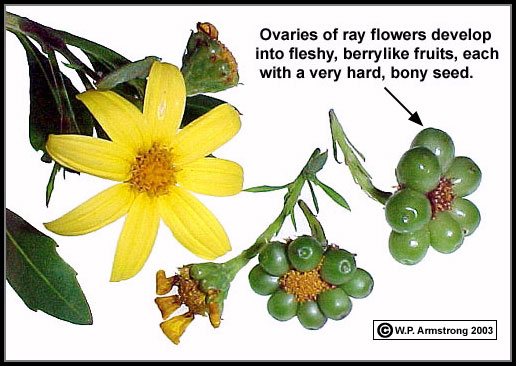
|
Boneseed (Chrysanthemoides monilifera ssp. monilifera). The flowers of boneseed are unusual among sunflowers because the ray flower ovaries develop into an enlarged berrylike fruit, each containing a very hard, bony seed. Up to 2500 seeds per square meter have been recorded beneath established boneseed colonies. The seeds are commonly spread by birds and animals that eat the fleshy fruit. They digest the fruit, but the hard seed passes unharmed through their digestive system. Harvester ants have been observed carrying the fruits to their nests where they eat the flesh and discard the seeds. Brush fires may also stimulate seed germination by fracturing (splitting) the resistant seed coat along sutures, thereby allowing the seeds to imbibe water. Fruits and seeds are also carried in moving water.
Boneseed and the closely-related bitou bush (Chrysanthemoides monilifera ssp. rotundifolia) were imported into Australia as ornamentals in the 1850s. They may have also been introduced unintentionally in a ballast dump from a South African ship. Boneseed and bitou bush are now two of Australia's most widespread and damaging environmental weeds. Several insect species have been introduced for biological control, including the soft shoot tip moth (Comostolopis germana) and boneseed beetles of the genus Chrysolina. Chrysolina beetles, including (C. quadrigemina) have been used successfully on Klamath weed (Hypericum perforatum) infestations in California.
Originally planted on the Palomar College campus about 20-25 years ago, boneseed has become naturalized in the nearby hills of coastal sage scrub; however, it appears to grow best during years with average to above average winter rains. During successive dry years it seems to prefer areas with more soil moisture, such as ravines at the base of the Palomar College Arboreteum.
|
Senecio: One of the largest genera of flowering plants with more than 2,000
species distributed throughout the world. It includes annual and perennial herbs,
climbing vines, shrubs, and xerophytes with fleshy (succulent) leaves and stems.
|

|
Senecio lyonii on San Clemente Island off the coast of San Diego County, California. This island endemic also occurs on Santa Catalina Island and on Guadalupe Island in Mexico.
|

|
Senecio lyonii on San Clemente Island off the coast of San Diego County, California. This island endemic also occurs on Santa Catalina Island and on Guadalupe Island in Mexico.
|

|
Senecio ganderi, an uncommon chaparral species that grows on Magee Ridge in the foothills of Palomar Mountain. Like other rare plants in San Diego County, this species grows on adobe-like Las Posas soils derived from weathered Gabbro.
|
|
"String of beads" (Senecio rowleyanus): A succulent, mat-forming Senecio native to southwest Africa. The globose, fleshy leaves resemble peas. Each discoid head (composed only of disk flowers) is produced on a leafless stalk (peduncle) that extends above the bead-like leaves. This species is distinguished from the closely-related S. citriformis by slit-like transparent "windows" seen when the leaves are observed under backlighting (right image). String of beads is commonly grown in hanging baskets in southern California. It certainly illustrates the remarkable diversity within this enormous genus of flowering plants.
|

|
San Diego gum plant (Grindelia camporum var. bracteosum), a resinous California wildflower used to relieve poison oak dermatitis by native Americans and early immigrants. The unopened flower buds are covered with a white, sticky, aromatic resin that was applied to afflicted areas of the body. This species is listed in older references as G. robusta var. robusta.
|

|
Coast gum plant (Grindelia stricta var. platyphylla), a low, spreading shrub native to windswept coastal bluffs and dunes in California and the Channel Islands..
|

|
A meadow of tidy tips (Layia platyglossa) and goldfields (Lasthenia californica) near Cuyamaca Lake in San Diego County.
|

|
Tidy tips (Layia platyglossa) in a meadow near Cuyamaca Lake in San Diego County, California.
|
|
References About The Sunflower Family
- Armstrong, W.P. 2000. "Those Blooming Sunflowers!" Zoonooz 73 (4): 28-31.
- Carlquist, S., B.G. Baldwin, and G.D. Carr, Editors. 2003. Tarweeds & Silverswords: Evolution of the Madiinae (Asteraceae). Missouri Botanical Garden Press, St. Louis, Missouri.
- Carlquist, S. 1980. Hawaii: A Natural History. Pacific Tropical Botanical Garden, Lawai, Kauai, Hawaii.
- Jansen, D.H. (Editor). 1983. Costa Rican Natural History. The University of Chicago Press, Chicago, Illinois.
- Kepler, A.K. 1984. Hawaiian Heritage Plants. Oriental Publishing Company, Honolulu, Hawaii.
- Rock, J.F. 1974. The Indigenous Trees of the Hawaiian Islands. Pacific Tropical Botanical Garden, Lawai, Kauai, Hawaii. Charles E. Tuttle Company, Rutland Vermont.
- Wagener, W.L., D.R. Herbst and S.H. Sohmer. 1999. Manual of the Flowering Plants of Hawaii. Volumes 1 & 2 (Revised Edition). Bishop Museum Press, Honolulu, Oahu, Hawaii.
- Walters, D.R. and D.J. Keil. 1996. Vascular Plant Taxonomy. (Fourth Edition). Kendall/Hunt Publishing Co., Dubuque, Iowa.
|
|

